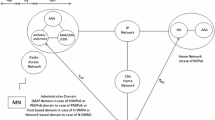Abstract
Our paper explores the issue of how to provide appropriate quality of service mechanisms closely integrated with flexible mobility management in wireless local area networks. We consider them as access networks of choice for the high performance Wireless Mobile Internet. We present a hierarchical QoS architecture that extends Differentiated Services (DiffServ) to mobile hosts in a wireless environment. Our approach is based on controlling several parameters of a wireless LAN cell: the limited geographical span to ensure the same high bit rate for all hosts, the constrained rate of traffic sources to limit the use of the channel in function of the required QoS and the limited number of active hosts to keep the load sufficiently low. The QoS management is coupled with mobility management at the IP level. We use a micro-mobility scheme implemented in the IPv6 layer with fast hand-offs between adjacent cells. Micro-mobility avoids address translation, traffic tunneling, and enables fast hand-offs. We give some details of experiments to show the quality of service differentiation over the 802.11b network.
Similar content being viewed by others
References
I. Aad and C. Castellucia, Differentiation mechanisms for IEEE 802.11, in: INFOCOM (2001).
ANSI/IEEE, 802.11: Wireless LAN Medium Access Control (MAC) and Physical Layer (PHY) specifications (2000).
M. Barry et al., Distributed control algorithms for service differentiation in wireless packet networks, in: INFOCOM (2001).
G. Bianchi, Performance analysis of the IEEE 802.11 Distributed Coordination Function, JSAC Wireless Series 18(3) (2000).
S. Blake et al., An architecture for Differentiated Services, Internet RFC 2475 (1998).
T. Bonald et al., Analytic evaluation of RED performance, in: INFOCOM' 2000 (March 2000) pp. 1415-1424.
R. Braden et al., Integrated Services in the Internet architecture: an overview, Internet RFC 1633 (1994).
F. Cali, M. Conti and E. Gregori, IEEE 802.11 wireless LAN: Capacity analysis and Protocol enhancement, in: INFOCOM (1998).
A.T. Campbell et al., An overview of cellular IP, in: IEEE Wireless Communications and Networks Conference, WCNC (1999) pp. 606-611.
D. Chalmers et al., A survey of Quality of Service in mobile computing environments, IEEE Online Communication Surveys 2(2) (1999).
J. Chan et al., The challenges of provisioning real-time services in wireless Internet, Telecommunications Journal of Australia 50(3) (2000).
A. Helal et al., Towards integrating wireless LANs with wirelessWANs using mobile IP, in: IEEE Wireless Communications and Networks Conference, WCNC (2000).
@IRS, Integrated architecture for networks and services, RNRT Project (2001), http://www/rp.lip6.fr/airs/
S. Lee and A.T. Campbell, INSIGNIA: in-band signaling support for QOS in mobile ad hoc networks, in: Mobile Multimedia Communications, MoMuC (1998).
A. Lindgren et al., Evaluation of Quality of Service schemes for IEEE 802.11 wireless LANs, in: Proceedings of the 26th Annual IEEE Conference on Local Computer Networks (LCN 2001) (November 2001).
A. Lindgren et al., Quality of Service schemes for IEEE 802.11 - a simulation study, in: Proceedings of the Ninth International Workshop on Quality of Service (IWQoS 2001) (June 2001).
D. Mitzel, Overview of 2000 IABWireless Internetworking Workshop, Internet RFC 3002 (2000).
S. Mukkamalla and B. Raman, Latency and scaling issues in mobile IP, ICEBERG Technical Report (2001).
C.E. Perkins, Mobile IP specification, Internet RFC 2002 (1996).
C.E. Perkins and D.B. Johnson, Mobility support in IPv6, in: Mobile Computing and Networking (1996) pp. 27-37.
R. Ramjee et al., HAWAII: a domain-based approach for supporting mobility in wide-area wireless networks, in: IEEE Internat. Conf. Network Protocols (1999).
A. Valko, Cellular IP - a new approach to Internet host mobility, ACM Computer Communication Review (1999).
J. Weinmiller et al., Performance study of access control in wireless LANs - IEEE 802.11 DFWMAC and ETSI RES 10 HIPERLAN, Mobile Networks and Applications 2(1) (1997) 55-67.
B. Zhang et al., WF2Q: Worst-case fair weighted fair queueing, in: INFOCOM 96 (1996).
Author information
Authors and Affiliations
Rights and permissions
About this article
Cite this article
Garcıa-Macıas, J.A., Rousseau, F., Berger-Sabbatel, G. et al. Quality of Service and Mobility for the Wireless Internet. Wireless Networks 9, 341–352 (2003). https://doi.org/10.1023/A:1023647311052
Issue Date:
DOI: https://doi.org/10.1023/A:1023647311052




